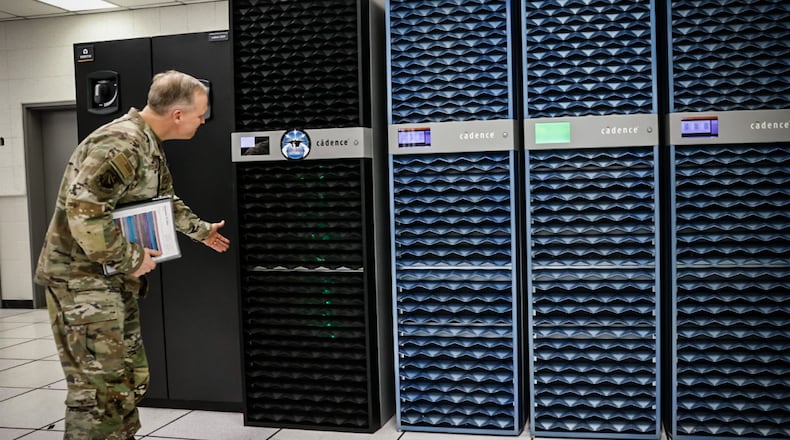“Your phone, the camera you’re using right now, those were all tested virtually,” said Joseph Baker, director of engineering and technical management for the F-35 JPO. “We’re trying to do the same thing with our military electronics.”
“We’re bringing modern commercial microelectronics development and verification technology into the DOD (Department of Defense),” said Brian Dupaix, of AFRL’s Trusted Electronics Branch.
The investment means new servers at an AFRL’s center on Wright-Patterson, one of several “High Performance Computing” centers across the DOD dedicated to research and testing. Other servers that were part of the investment are located with DOD partners at other, undisclosed locations.
Each center boasts powerful computing infrastructure, high-speed networks, the ability to store data on the order of multi-petabytes and more. (A petabyte is equivalent to a million gigabytes, about 500 billion pages of standard printed text.)
While the technology is cutting edge, the idea is simple: Harness digital engineering and supercomputing to help those who fight wars win those wars.
These upgrades are designed to accelerate the development of advanced technology and digital solutions to boost warfighter readiness.
“The United States has the best microelectronics development infrastructure in the world,” Dupaix said. “Some of our large companies — I won’t mention any specific names; you know who they are — develop the best microelectronics technologies that exist on the planet.”
The idea with this investment is to bring that kind of power into the Air Force for national defense.
Some of the most key warfighting capabilities you can imagine — finding the right target, hitting that target, making the right decisions in the heat of battle — depend on microelectronics.
“We need things like communications,” said Yadunath Zambre, chief microelectronics technology officer for AFRL. “We need things like the ability to launch a weapon. We need the weapon to be able to hit the target accurately, which means the weapons have to have sensing capabilities.”
Air Force planes need to avoid enemy weapons while dealing with jamming and interference by the enemy. On top of all that, pilots and warfighters need intelligence at the right time.
“That means the ability to make decisions and make sure those decisions are well understood and practical and safe — a tough thing to do,” Zambre said.
Erman Cordova, the F-35 JPO digital engineering and transformation lead, called the investment the culmination of years of work. “This is an essential piece of technology and processing tool for us to be successful,” he said.
With the help of the Beavercreek-based Midwest Microelectronics Consortium, this upgraded computing infrastructure will support the F-35 program, the Navy (which has a presence on Wright-Patterson), DARPA and other DOD projects.
AFRL, headquartered at Wright-Patterson, is a global organization conducting the research the Air Force needs.
About the Author


